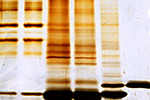Institut für Molekulare Biowissenschaften

Colloquium
Microbial oxidation of atmospheric trace gases: from enzymes to ecosystems
Julian von Ehr - Molecular basis of alternative splicing regulation through SRSF6 isoforms
Uwe Bodensohn - GET3B the central ATPase of the stromal GET pathway
Raphael Trischler - Novel metabolic features of human gut microbes
Jan-Niklas Tants - Molecular mechanisms of Roquin-RNA complex formation
Jennifer Roth - Structure and function of the Rnf complex, an ancient respiratory enzyme
Max Angstenberger - Genome Editing in Chlamydomonas reinhardtii
*Science in progress represents talks of institute members. Either
post docs or advanced PhD students present and discuss their
recent data.

Forschungsthemen
| Lehrstuhl | Anrede | Vorname | Nachname | ||||
| Biologie und Genetik von Prokaryonten | Prof. | Jörg | Soppa | ||||
| Molekulare Biotechnologie | Prof. | Helge | Bode | ||||
| Molekulare Mikrobiologie und Bioenergetik | Prof. | Volker | Müller | ||||
| Molekulare Mikrobiologie und Bioenergetik | Prof. | Beate | Averhoff | ||||
| Molekulare Zellbiologie der Pflanzen | Prof. | Enrico | Schleiff | ||||
| mRNA-based gene regulation | Dr. | Andreas | Schlundt | ||||
| Naturstoffgenomik | Prof. | Eric | Helfrich | ||||
| Pflanzengenetik | Prof. | Yvonne | Stahl | ||||
| Pflanzliche Zellphysiologie | Prof. | Claudia | Büchel | ||||
| Physiologie und Genetik niederer Eukaryonten | Prof. | Eckhard | Boles | ||||
| RNA Regulation in Higher Eukaryotes | Prof. | Michaela | Müller-McNicoll | ||||
| RNA-Strukturbiologie | Prof. | Jens | Wöhnert |
Institut für Molekulare Biowissenschaften
Campus Riedberg
Biozentrum N210-207
Postfach 6
Max-von-Laue-Straße 9
60438 Frankfurt
T +49 69 798-29603
F +49 69 798-29600
E info-mbw@bio.uni-frankfurt.de
WhatsAPP +49 1525 4967321
Geschäftsführender Direktor:
Prof. Dr. Michaela Müller-McNicoll
gd.mbw@bio.uni-frankfurt.de
Stellv. Geschäftsführende Direktorin:
Prof. Dr. Claudia Büchel
Allgemeine Informationen:
Dr. Markus Fauth
T 069 798 29603
Dr. Matthias Rose
T 069 798 29529
Nadine Schwedler
T 069 798 29699
- Aktuelles und Presse
- Pressemitteilungen
- Öffentliche Veranstaltungen
- Uni-Publikationen
- Aktuelles Jahrbuch
- UniReport
- Forschung Frankfurt
- Aktuelle Stellenangebote
- Frankfurter Kinder-Uni
- Internationales
- Outgoings
- Erasmus / LLP
- Goethe Welcome Centre (GWC)
- Refugees / Geflüchtete
- Erasmus +
- Sprachenzentrum oder Fremdsprachen
- Goethe Research Academy for Early Career Researchers
- Forschung
- Research Support
- Forschungsprojekte, Kooperationen, Infrastruktur
- Profilbereich Molecular & Translational Medicine
- Profilbereich Structure & Dynamics of Life
- Profilbereich Space, Time & Matter
- Profilbereich Sustainability & Biodiversity
- Profilbereich Orders & Transformations
- Profilbereich Universality & Diversity















